|
|
|
Sort Order |
|
|
|
Items / Page
|
|
|
|
|
|
|
| Srl | Item |
| 1 |
ID:
155918
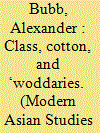

|
|
|
|
|
| Summary/Abstract |
This article makes use of a recently unearthed archive in Sweden, complemented by research in the India Office Records and Maharashtra State Archives, to explore the business networks of the small-scale railway contractor in 1860s Bombay Presidency. The argument centres on the career of one individual, comparing him with several contemporaries. In contrast to their civilian colleagues, freebooting engineers have been a somewhat understudied group. Sometimes lacking formal technical training, and without an official position in colonial India, they were distrusted as profiteering, even corrupt, opportunists. This article will present them instead as a diverse professional class, incorporating Parsis alongside various European nationalities, who became specialists in local milieux, sourcing timber and stone at the lowest prices and retaining the loyalty of itinerant labourers. It will propose that the 1860s cotton boom in western India provided them with a short-lived window of opportunity in which to flourish, and to diversify into a variety of speculative enterprises including cotton trading, land reclamation, and explosives. The accidents and bridge collapses of the 1867 monsoon, and subsequent public outcry, will be identified as a watershed after which that window of opportunity begins to shut. The article's concluding section analyses the contractors’ relationship with their labour force and its intermediary representatives, and strategies for defusing strikes. Ultimately, small independent contractors were agents of modernity not formally affiliated with the imperial project, and forced to bargain with merchants and strikers without official backing. Theirs is a record of complex negotiations at the local level, carried out in the immediate post-Mutiny settlement.
|
|
|
|
|
|
|
|
|
|
|
|
|
|
|
|
| 2 |
ID:
161699
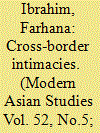

|
|
|
|
|
| Summary/Abstract |
This article examines intersections between sexuality, migration, and citizenship in the context of cross-border and cross-region marriage migration in Kutch, Gujarat, to underscore that women's mobility across borders is one site on which national cultural and political anxieties unfold. It argues that contemporary cross-region marriage migration must be located within the larger political economy of such marriages, and should take into account the historical trajectories of marriage migration in particular regions. To this end, it examines three instances of marriage migration in Kutch: the princely state's marriages with Sindh, nineteenth-century marriages between merchants from Kutch and women from Africa, and contemporary marriage migration into Kutch from Bengal. The article asks whether the relative evaluation of these marriages by the state can be viewed in relation to the settlement policies undertaken after partition, where borderlands were to be settled with those who were deemed loyal citizens. Finally, by historicizing marriage—as structure, but also aspirational category—it seeks to move away from the singularity of marriage as framed in the dominant sociological discourse on marriage in South Asia.
|
|
|
|
|
|
|
|
|
|
|
|
|
|
|
|
| 3 |
ID:
164870
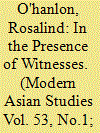

|
|
|
|
|
| Summary/Abstract |
British observers of the nineteenth-century panchayat were convinced that it represented a judicial forum of great antiquity, in which petitioners were able to gain local and direct access to justice. They contrasted the panchayat favourably with the delays and frustrations that beset the eighteenth-century East India Company's attempts to channel all petitions through its own courts. This article examines the history of the pre-colonial panchayat in western India and its early modern predecessors. During the early modern centuries, a diverse array of state-level and local corporate bodies made up the landscape for the submission of petitions and the hearing of suits. Although many suits were local in nature, the process of hearing and adjudication itself gave these judicial spaces a significant ‘public’ dimension, and their forms of argumentation frequently invoked general principles of justice and moral order. From the early eighteenth century, the new form of the panchayat came to supersede these older corporate bodies and to reshape the forms of public that gathered around them. The Maratha state, based in Pune, sought firmer control over revenue and justice. State officials promoted the panchayat as a new type of judicial arena, weakening the local corporate institutions and tying them more closely to the Pune court.
|
|
|
|
|
|
|
|
|
|
|
|
|
|
|
|
| 4 |
ID:
144226


|
|
|
|
|
| Summary/Abstract |
In examining the remarkable expansion of India's textile production in the late colonial period, many scholars have identified consumption trends as shaping the relative success of mills as opposed to handlooms. That scholarship, however, has focused on only one component of consumption: clothing. This article explores another important area of cloth consumption in western India: non-clothing textiles. Across classes, urban dwellers used curtains and furnishing fabrics to try to improve comfort and create privacy—two qualities in short supply in cities like Bombay and Ahmedabad, where the pressures of rapidly growing populations came into conflict with new sanitary demands to open up houses to light and air. More broadly, non-clothing textiles helped to negotiate the novel conditions of urban life, where people moved regularly, homes were increasingly open to non-kin visitors, men and women shared space in new ways, and elite women were aesthetic arbiters of domestic space. While clothing choices in the late colonial period have often been studied in the context of nationalism, this article argues that nationalism was only one factor among many that shaped the use of household furnishing fabrics; equally, or more importantly, new ideas of ‘home’ led to and were expressed in expanded fabric use in urban western India.
|
|
|
|
|
|
|
|
|
|
|
|
|
|
|
|
| 5 |
ID:
123065
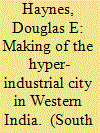

|
|
|
|
|
| Publication |
2013.
|
| Summary/Abstract |
This essay explores the rapid expansion of small handloom centres in Western India between 1930 and 1970. It attributes the transformation of these places into larger cities to the role of local weaver-capitalists, who developed new markets for local textiles and introduced significant technological innovations into the industry, and who forged strategies for combatting the growth of labour resistance. The essay also highlights the role of the late colonial and early post-Independence states, which promoted the growth of weavers' co-operatives and which imposed extensive regulations on larger enterprises. The paper argues that the powerloom centres of Western India sustained a 'hyper-industrial' quality, with limited economic or cultural diversification, restricted urban amenities and public services, and the extensive concentration of poor urban migrants in slums.
|
|
|
|
|
|
|
|
|
|
|
|
|
|
|
|
| 6 |
ID:
102002


|
|
|
| 7 |
ID:
116078
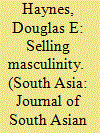

|
|
|
|
|
| Publication |
2012.
|
| Summary/Abstract |
This essay discusses advertising for sex tonics in Western Indian newspapers between 1900 and 1945. It specifically focuses on the emergence of a new paradigm of tonic advertisement-the marital happiness advertisment-after 1935. Arguing that tonic advertisers always sought to develop appeals grounded in prevously circulating conceptions of sexuality and the body, it first examines pre-1935 forms of advertisement submitted by local businesses and global corporations. It then turns to discussion of the marital happiness ads, which stress the modern husband's need to satisfy his wife sexually, demonstrating that this trope was strongly influenced by the development of global sexology. These ads, however, resorted to a hybrid reasoning, which also included the kinds of logic found in earlier advertisements, especially those about 'semen anxiety'.
|
|
|
|
|
|
|
|
|
|
|
|
|
|
|
|
| 8 |
ID:
155121


|
|
|
|
|
| Summary/Abstract |
This article examines letters written by young men to the Marathi-language journal Samaj Swasthya and its editor, R. D. Karve, a major advocate of birth control and sex education in western India. The letters, and Karve's responses to them, constituted perhaps the earliest sex-advice column in Indian print media. We argue here that the correspondence provides a unique vehicle for understanding the forms of sexual knowledge held by middle-class males in mid-twentieth-century India as well as for appreciating their most significant sexual anxieties. The article analyses the concerns expressed in the letters about masturbation and seminal emissions, the nature of the female body and processes of conception, birth control and same-sex sexual practices. It particularly illuminates the ways in which the concept of modern conjugality pervaded the sexual understandings of the young men who wrote to Karve. It thus offers valuable insights into specifically sexual aspects of conjugality and masculinity—aspects that have previously been unexplored.
|
|
|
|
|
|
|
|
|
|
|
|
|
|
|
|
| 9 |
ID:
031207
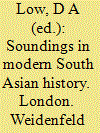

|
|
|
|
|
| Publication |
London, WeidenFeld and Nicolson, 1968.
|
| Description |
viii, 391p.hbk
|
|
|
|
|
|
|
|
|
|
|
|
Copies: C:1/I:0,R:0,Q:0
Circulation
| Accession# | Call# | Current Location | Status | Policy | Location |
| 000681 | 954.04/LOW 000681 | Main | On Shelf | General | |
|
|
|
|
|
|
|
|
|